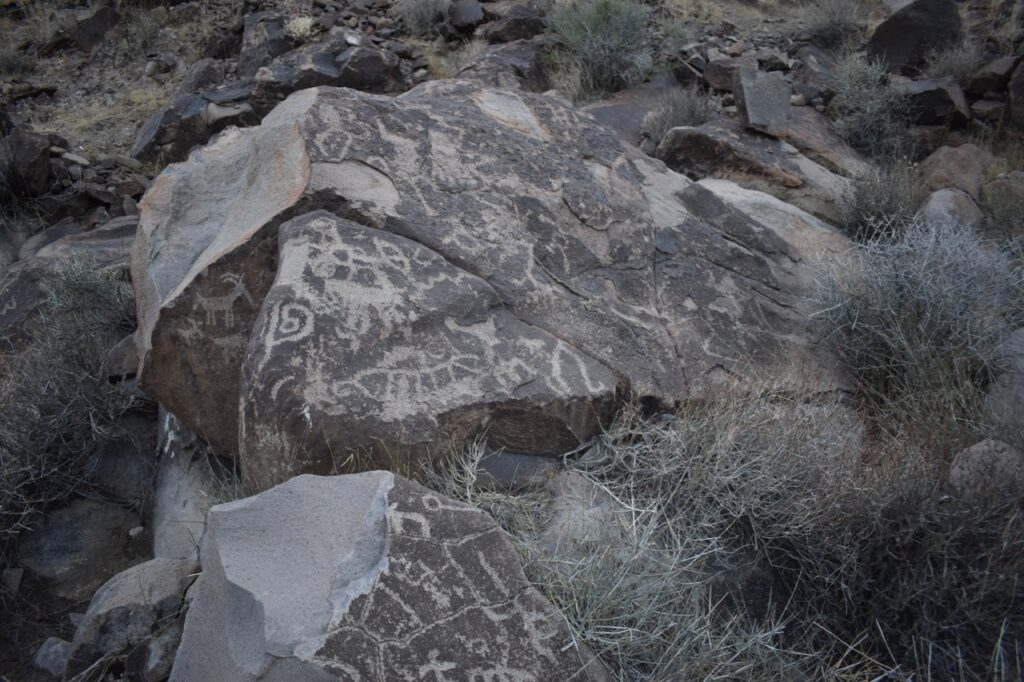
The American Southwest: Beyond the Modern Lens
Nestled in the heart of the Mojave desert lies a plethora of hidden treasures. The ghosts of old frontiersmen and lost civilizations haunt the landscape—remnants of a people and culture that transformed the land. You are surrounded by millions of years of environmental change—from the sculpting of sandstone canyons to the evolution of unique plant communities—that define the foundations of our planet. In the face of all these remarkable feats, Las Vegas, like many other cities across the United States, have become burdened by a uniform vision: it’s just one other place to party. Entertainment and consumerism have defined the modern culture, blinding us from the grandeur of natural history and the struggles of the ancestors. Earlier peoples recognized the importance of place in building a unique culture that would unite their civilization and assert their desires and ambitions onto the greater political landscape.
The Urban Idea
Before the dawn of civilization, prehistoric men were hunter-gatherers; they stalked dangerous beasts and searched for various plants and berries, all in an effort to survive. Their bodies were subjected to the harsh elements and they spent most of their lives interacting with very small groups of people. Simple tools and weapons made out of wood, stone, and bone materials acted as defense against wild animals or other tribes, while assisting with the basic needs of food and shelter. Much of what we know of their lifestyle is by studying these artifacts, since unfortunately there is no written record of the time. Based on the archaeological evidence, prehistory is marked by three defining groups: Paleolithic (2.5 million years – 10,000 BC) tribes were more stationary residing in caves and huts; later in the Mesolithic (10,000 BC – 8,000 BC) period, humans were becoming more of a nomadic people, congregating along rivers and other water sources; but in the Neolithic (8000 BC – 3000 BC) Age, the invention of agriculture replaced the old hunter-gatherer lifestyle and generated the growth of human settlements into models for structured societies.
At about 3000 BC, Mesopotamia became one of the great epicenters of this contemporary idea. Between the Tigris and Euphrates River, new advancements in agriculture and economics transformed small villages into large city-states that thrived in the region. Canal networks were established to irrigate crops on this fertile land, and new technologies helped make farming more reliable and efficient. As the idea of the city became more standardized, writing systems were needed to communicate and track ongoing processes. Although difficult for the common citizen to learn, the Sumerians utilized cuneiform as their written language, but later civilizations such as the Akkadians and Babylonians developed an improved syllabic script that encouraged literacy and dissemination of knowledge within the new society. With all of this extensive growth, Mesopotamian peoples were inspired to reach beyond improvements to basic survival to meditating on a higher potential for mankind. Advancements in science, philosophy, music, along with many other key areas, led to fascinating progress in establishing a growing culture and uniting avenues of expression among these various peoples. A revolution was truly underway, and Mesopotamia would set the framework for future cities such as the political vanguard of Athens and the frightening power of Rome.
Today, nearly 80 percent of Americans live in an urban area. It is where we first go to school, where we grow up and meet our childhood friends; and as an adult, where we often find work, and where we spend our free time to enjoy ourselves. Whether it’s going out to see a movie or visiting the popular restaurant downtown, the city is a centralized hub that offers great convenience to the public. With so many opportunities within reach, it’s no surprise that people are choosing cities as their primary place to reside.
But how does our modern city compare to the great civilizations of the past or even the regional differences of the days of early industry? It is true that most citizens speak a common language; much of our laws and governments are built on the foundations of the Roman Empire; our systems of thought have progressed through the maturation of Western philosophy; and our technologies have advanced to unbelievable levels, yet, a simple plane ride across vast regions of the United States would showcase the same lifeless monoculture of the American Dream—concrete shopping plazas and asphalt highways. To anyone outside of the country, American culture is burgers, pizzas, and Hollywood; culture has become something consumed from the top down rather than allowing itself to flourish within natural developments of human progress.
Nature and Place
The Southwest region of the United States is home to four major deserts: Great Basin, Mojave, Sonoran, and Chihuahuan—two of these encompassing the entire state of Nevada! In the north, the higher elevations of the Great Basin Desert create unusually cool temperatures during most of the season, while the lower valleys of the Mojave along the southern tip can be dangerously hot in the peak of summer. Both of these regions hold unique plant and wildlife communities that have adapted to live in such dry barren soil and extreme conditions. The oldest known living trees in the world—over 5,000 years old—reside and populate within this northern locality. The Great Basin Bristlecone Pine (Pinus longaeva) is an interesting specimen that has adapted to the alkaline soils of the sub-alpine desert climate. While not the ideal soil type, it has discovered this niche as a favorable place to grow with low competition from other plant species and safety from wildfires. By dissecting information from its growth rings, it is an important resource for dendrochronologists looking to study historical data of the Earth’s changing climate. Another more familiar tree species is the Joshua Tree (Yucca brevifolia) which is exclusive to the south. A vestige to the ancient past, these flora were fed upon by the naturally extinct Shasta Ground Sloth (Nothrotheriops shastensis), which greatly helped to distribute the seed to more favorable areas. Although it is still critical habitat for Mojave ecology—pollinated only by the Yucca Moth (Tegeticula yuccasella)—it is thought that the impact of climate change and limited seed-distributers could see major reduction or loss of this crucial plant.
As you can see, deserts are fragile ecosystems because the lack of water and rainfall makes it difficult for any kind of organic life to survive. However, before European settlement, the Southwest was home to many civilizations: the Desert Archaic (8000 BC – AD 500), Anasazi and Patuyan (AD 1 – AD 1150), and Southern Paiute (AD 1150 – present) who accustomed their ways to this dry hot climate. Whether foragers or farmers, these native communities placed significant importance on the land. It was the bringer of life and the bearer of death; the survival of prospective generations depended on this sacred knowledge: recognizing the activities and locations of wild mammals and understanding the seasonal changes of plant and weather cycles was critical to life. Native tribes would often move with the seasons to take advantage of the abundance of food in different regions. Native plants such as yuccas, agaves, and the fruits of mesquite and pinyon pine were only some of the key plants that were collected. Resources to build homes depended on materials in the open country, whether that be a simple stone or brush dwelling or a pit house.
Modern life is far removed from this harsh reality of survival. In exchange for labor, we earn money that allows us to fulfill our basic needs. We have a roof over our head and food in our belly. Nature to us is not a vital resource but a commodity that can be exploited for our needs and pleasures. We go on a road trip to our favorite lake to relax, or hike up a mountain to snap a selfie to show how amazing of a life we live, without understanding the important infrastructure these serve for the creatures around us. Our backyards and cities have become ecological wastelands of “neat and tidy” turf grass lawns and sterile flowers of “pretty” non-native plant species. An even greater problem of modern civilization is how it stresses the importance of fertile land, so we plant foreign crops to supply our food system without recognizing the disturbances we make to the planet and life around us. To our desolate cities, “green” is a virtuous replacement to our vast highways of concrete and asphalt, boring architecture wastelands, and banal inventions of modern culture.
Hitting the Dirt
“What brings you to Las Vegas?” Flights were completely full, there were almost no vehicles available, and the place was absolutely packed. “Why is it so busy?” I saw a couple contestants for the Miss America pageant walk by and a couple greeters for UFC, so there was certainly a lot going on. Many people said they were traveling to bet on sports and take part in March Madness. Others were probably blowing their newly received stimulus cash over in the casinos. Out of all the people who come to Las Vegas, I was probably the only one who went straight to the mountains. To the millions who visit the city and many who live here, they are blind to what they are missing.



Arriving at the trailhead in the late afternoon, I felt like I was in the middle of nowhere. Sloan Canyon is about 25 miles south of Las Vegas and my phone was barely hanging on with 1% battery life. After about 30 minutes on the trail, it was just me and this isolated desert landscape. Yet, “Desolation Row” was miles beyond, but equipped with the right pair of glasses, one can see a sense of beauty in this diverse landscape. For one unfamiliar with the local ecology, early March is still too early to see many flowers and can be difficult for plant identification, but you can still investigate morphological characteristics and leftover signs of the late stages of fall and winter to assist in the process. Fuzzy fruits on the dominant creosote (Larrea tridentata) bush were still dangling around in the wind; dried wildflower seed heads give ideas as to what will bloom in the next couple months; prickly pear (Opuntia spp.) and cholla (Cylindropuntia spp.) cacti feign death while they wait the awakening of the heavy spring rains; Mojave yucca (Yucca schidigera) with their strange tendrils and long spiked leaves guard the plains. In the distance, my ear captures a sound. Besides the tiny lizards scurrying across the trail and the occasional desert cottontail (Sylvilagus audubonii) in the low hills, this felt like the first bout of animal life on this expedition. Grabbing my binoculars, I see a small flight of birds with interesting black and white markings hopping about in the scrub—black-throated sparrows (Amphispiza bilineata)!
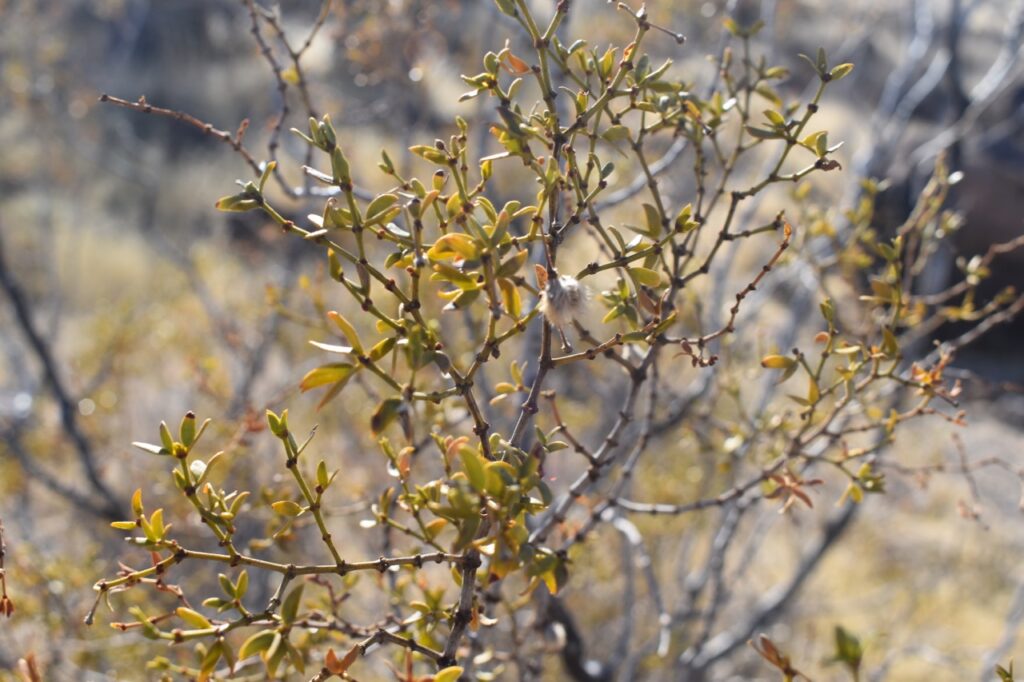
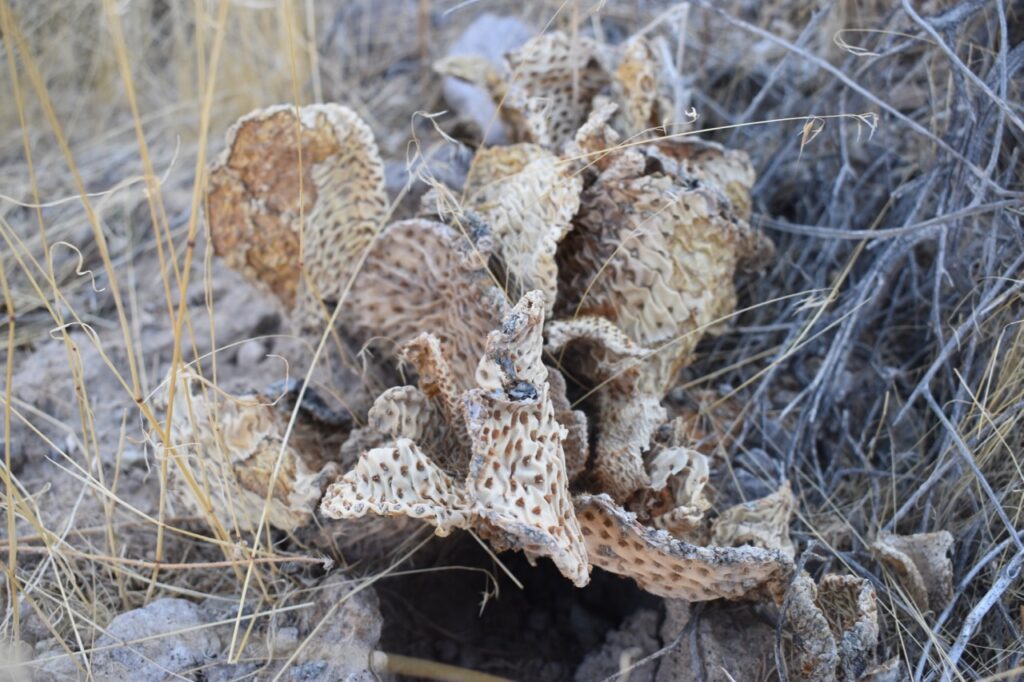
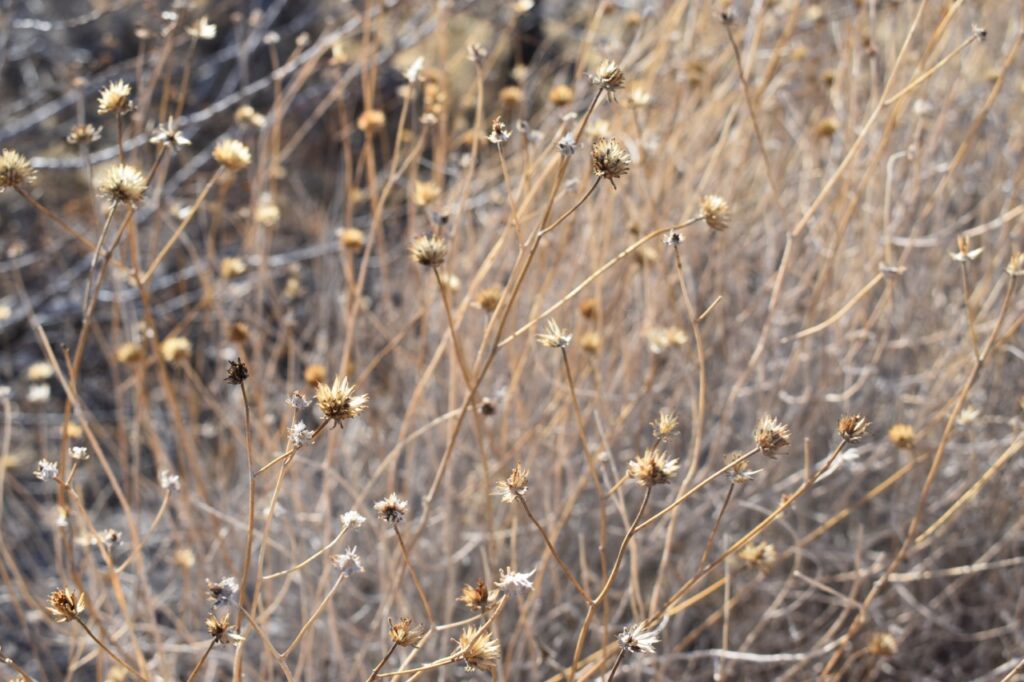
To me looking into the wild and studying the landscape is like a scavenger hunt. You collect species of plants and wildlife in your memory and work to understand their ecological connection. Studying their attributes can give indications as to their uses to the people who relied on this landscape to survive. Even before the industrialization of medicine, a knowledge of plants and natural remedies existed within the folklore of the American people. By piecing together these clues you are weaving together the stories of the landscape.
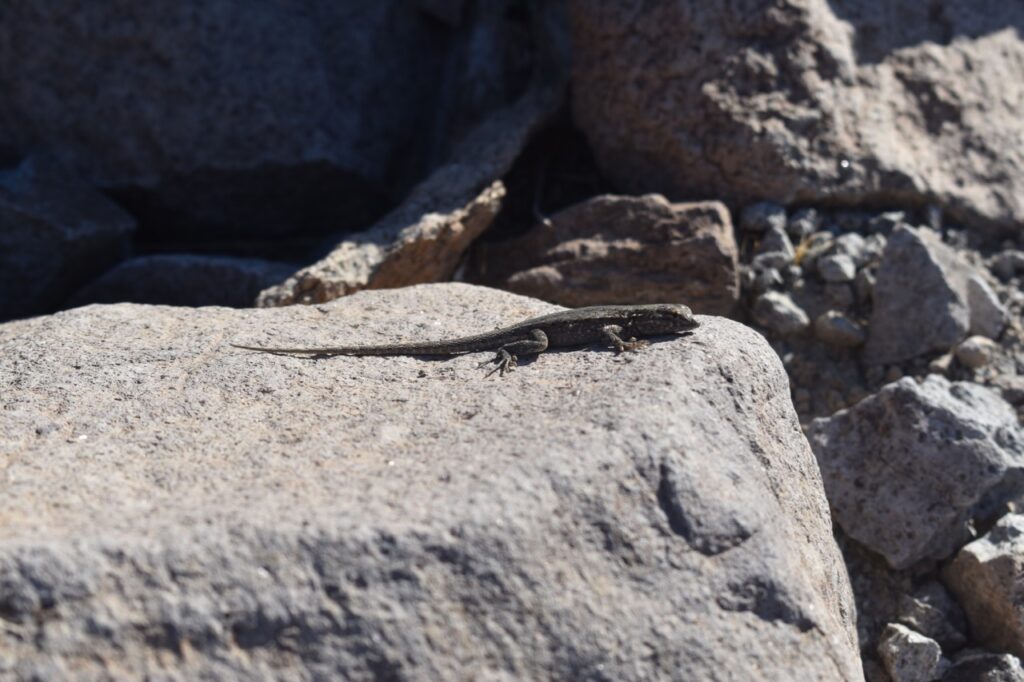

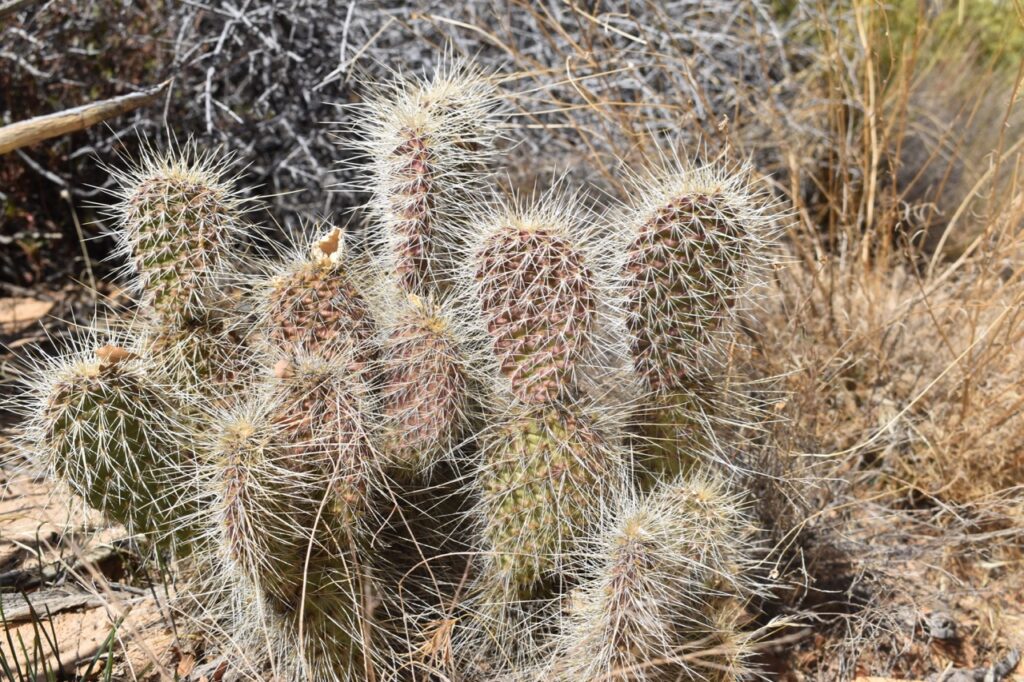
As I work my way back to the trailhead, I get to the real prize—Petroglyph Canyon. Carved into the rock are mysterious symbols, some of them clear enough to interpret as humans or animals. One petroglyph represents Bighorn sheep (Ovis canadensis) while others closely resemble humans and lizards. It is quite interesting to know that many of these same symbols are commonly found amongst the native Southwest peoples—very similar to other indigenous civilizations throughout the world. As dusk was approaching, I was surprised that none of the small bats flying right above my head hadn’t made a compelling appearance on the canyon rocks. Archaeologists have proposed theories as to what these drawings meant to these civilizations: some associate it as an early writing system that was used to communicate stories; others think it may have had some mystical connection with hunting or shamanic rituals. Whatever the meaning of this simple mode of expression, it is just one more fascinating clue to discovering the full history and significance of the region.
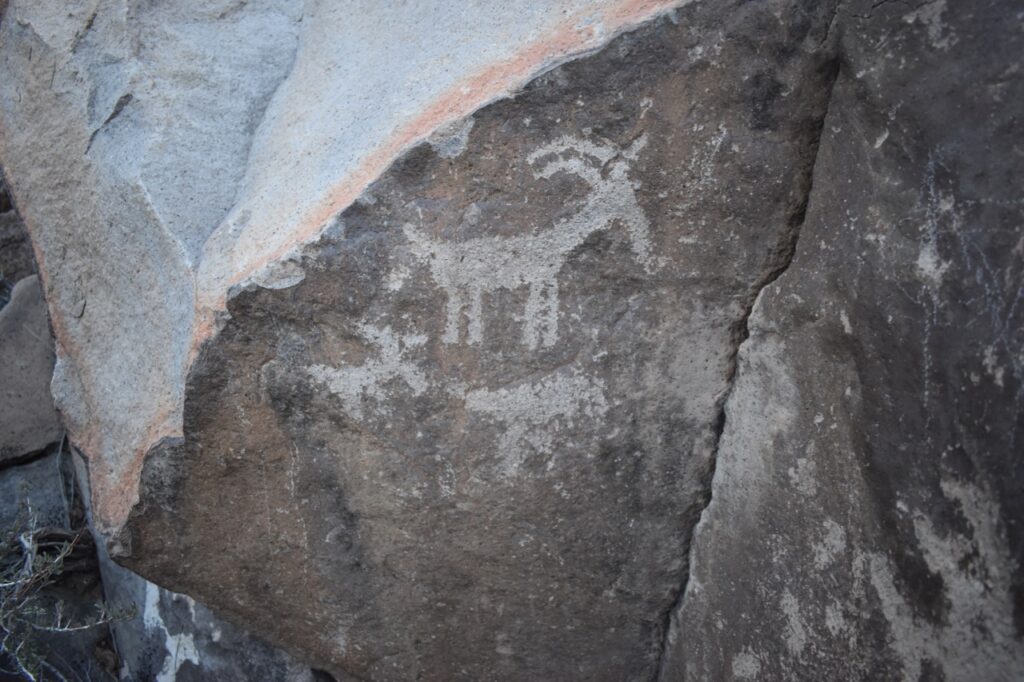

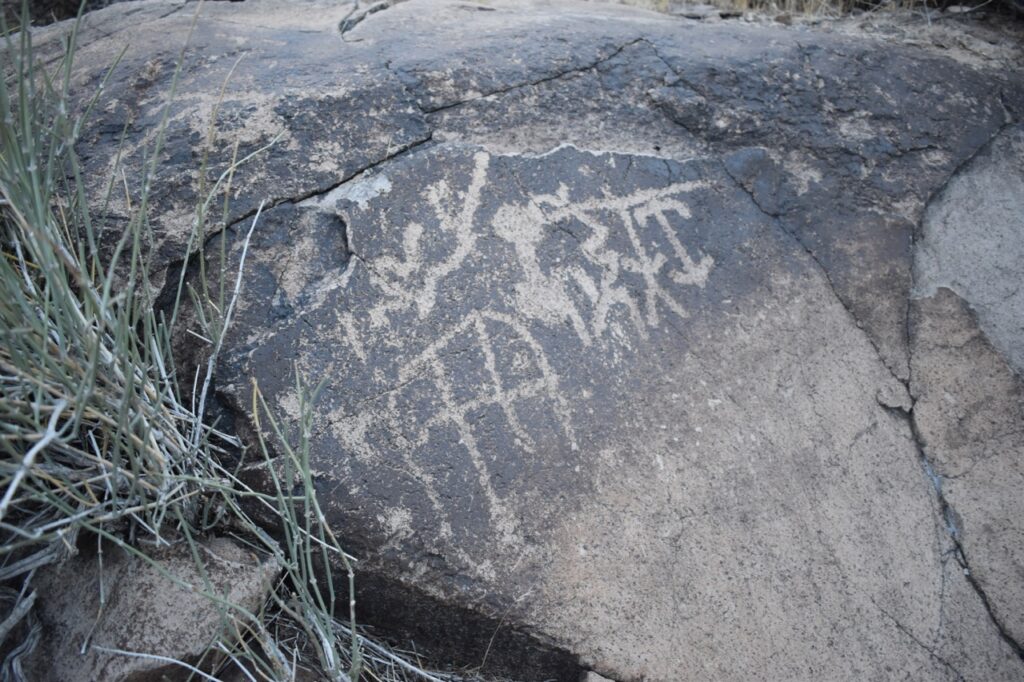
The Uphill Battle
Sustainability is a concept that is becoming popular in our modern culture, but is a difficult battle to achieve breakthroughs in the political realm. As Republicans and Democrats continue their bipartisan stalemate, our planet is warming, species biodiversity is falling at a frightening rate, and our close-minded societal practices continue to impact the planet in a severe way. With limited tools and technology, ancient history based their daily lives on not only what the land could give them, but also how they needed to give back to sustain it. While civilization sparked a revolution in advanced ideas and philosophy, it changed our fundamental way of living. We realized that we could manipulate the land for our sole benefit and forgot that we are not separate, but born out of this earth. We have designed our city trees as the skyscrapers that ascend above us. We create little suns that illuminate our dim lives. But this way of life has an expiration date, and as the population booms and more space is needed to fill this gap, we have no choice but to change. Becoming a sustainable society requires a shift in our normal mode of operation, and this will affect all aspects of life: political and economic systems, manufacturing, agricultural processes, and much more.
The modern city emphasizes consumption, conformity, and a simulation of life through our capitalist framework. Many of us spend forty hours a week working a job that fuels corporate power and further exploitation, rather than serving our basic needs and interests. Most of us can make enough money to provide food on the table and a roof over our heads, but we have little time or desire to engage in meaningful activities. Investing so much energy into these generalized jobs, we are separated from the cycle of life and the important ideas that will build us into better people. We know little about our history and the achievements and lessons of the people before us. We understand little of the importance of our regions and geography and the connections people have to the land. The culture and breakthroughs that the invention of civilization has given us are lost to the demands of the closed-loop system of capitalism.
Unfortunately, sustainability gathers much pushback from Big Business and the general public. Regulations surrounding environmentalism often focus on the negatives—”being less bad”—rather than highlighting the benefits a sustainability plan could give to a nation. While sustainability does target our inflated consumption rate, rather than holding us back, it actually helps build culture and ignite genuine advancements in our civilization. It demands the reformation of dominating power systems and integrates past connections into a new vision of the future. Recognizing how nature shapes our civilization and integrating our core processes into these ideas has the potential to transform our society in extraordinary ways. Like Mesopotamia, sustainability is the key to unlocking a new cultural revolution that would have a dramatic impact on the world stage.